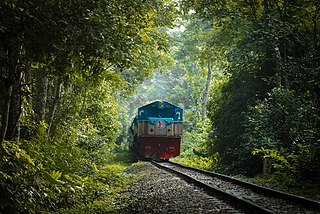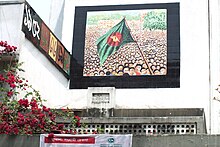
"Amar Sonar Bangla" is the national anthem of Bangladesh. An ode to Mother Bengal, the lyrics were written by Bengali polymath Rabindranath Tagore, while the melody is derived from Baul singer Gagan Harkara's "Ami Kothay Pabo Tare", set to Dadra tala. The modern instrumental rendition was arranged by Bangladeshi musician Samar Das.

The national flag of Pakistan, also known as the Flag of the Star and Crescent, is made up of a green field with a stylized tilted white descending crescent moon and five-pointed star at its centre, and a vertical white stripe at its hoist-end. Though the specific shade of green on the flag is mandated only as 'dark green', its official and most consistent representation is in Pakistan green, which is shaded distinctively darker. It was adopted by the Constituent Assembly of Pakistan on 11 August 1947, and it became the official flag of the Dominion of Pakistan on 14 August 1947, following independence from the British Empire. The flag was subsequently retained as that of the Islamic Republic of Pakistan in 1956 and remains in use as the national flag to this day.

Bangladesh Awami League, simply known as Awami League, is one of the major political parties in Bangladesh. The oldest existing political party in the country, the party played the leading role in achieving the independence of Bangladesh. It is also one of the two most dominant parties in the country, along with its archrival Bangladesh Nationalist Party.

The Jatiya Sangsad Bhaban is the house of the Parliament of Bangladesh, located at Sher-e-Bangla Nagar besides St. Joseph Higher Secondary School in the Bangladeshi capital of Dhaka. Designed while the country was still part of Pakistan by architect Louis Kahn, the complex is one of the largest legislative complexes in the world, covering 208 acres (840,000 m2).

Victory Day is a national holiday in Bangladesh celebrated on 16 December to commemorate the defeat of the Pakistan Armed Forces in the Bangladesh Liberation War in 1971 and the Independence of Bangladesh. It commemorates the Pakistani Instrument of Surrender, wherein the commander of the Pakistani Forces, General A. A. K. Niazi, surrendered to Lieutenant General Jagjit Singh Aurora, Joint Commander of Indian and Bangladesh Forces, ending the nine-month Bangladesh Liberation War and 1971 Bangladesh genocide and marking the official secession of East Pakistan to become the new state of Bangladesh.

The Bangla Academy is the official regulatory body of the Bengali language in Bangladesh. It is an autonomous institution funded by the Government of Bangladesh that fosters the Bengali language, literature and culture, works to develop and implement national language policy and conducts original research in Bengali. Established in 1955, it is located in the Burdwan House in Shahbagh, Dhaka, within the grounds of the University of Dhaka and Suhrawardy Udyan. The Bangla Academy hosts the annual Ekushey Book Fair.

Syed Shamsul Haq was a Bangladeshi writer. He was awarded Bangla Academy Literary Award in 1966, Ekushey Padak in 1984 and Independence Day Award in 2000 by the Government of Bangladesh for his contributions to Bangla literature. His notable works include "Payer Awaj Pawa Jai", "Nishiddho Loban", "Khelaram Khele Ja", "Neel Dongshon" and "Mrigoya".

Jagannath University (JnU) is a public university located in Sadarghat, Dhaka, the capital of Bangladesh. Founded as Dhaka Brahma School in 1858 and renamed Jagannath School in 1872, the institution was taken over by the Pakistani government in 1968, while Bangladesh was still a part of Pakistan. It opened graduate and post-graduate programmes in 1975 and was approved as a full public university in 2005.
Shib Narayan Das was a Bangladeshi designer and vexillographer, best known for designing the first iteration of the national flag of Bangladesh. His design also inspired the country's current flag. Das died in Dhaka on 19 April 2024, at the age of 77.
1971 (MCMLXXI) was a common year starting on Friday of the Gregorian calendar, the 1971st year of the Common Era (CE) and Anno Domini (AD) designations, the 971st year of the 2nd millennium, the 71st year of the 20th century, and the 2nd year of the 1970s decade.

Transport between India and Bangladesh bears much historical and political significance for both countries, which possessed no ground transport links for 43 years, starting with the partition of Bengal and India in 1947. The Kolkata–Dhaka Bus (1999) and the Dhaka–Agartala Bus (2001) are the primary road links between the two countries; a direct Kolkata-Agartala running through Dhaka, the capital of Bangladesh is being developed by both countries. The Maitree Express was launched to revive a railway link between Kolkata and Dhaka that had been shut for 43 years.

BBC Bangla is the Bengali language service of the BBC World Service, inaugurated in 1941 for Bengali audiences worldwide especially the ones in the Bengal region, which includes the sovereign state of Bangladesh and the Indian states of West Bengal and Tripura.

Musa Ibrahim is a Bangladeshi mountaineer, trekker, journalist, and author. He is the first Bangladeshi to reach the summit of Mount Everest. He reached the summit around 5:05 am BST on 23 May 2010 and hoisted the flag of Bangladesh on the apex of the world at around 5:16 am BST. From then, Bangladesh became the 67th Mount Everest conquering country.

Bashirul Haq was a Bangladeshi architect, town planner and visiting professor of MIT. He was regarded as one of the most influential architects in South Asia in terms of environmentally and socially responsive design.

The national symbols of Bangladesh consist of symbols to represent Bangladeshi traditions and ideals that reflect the different aspects of the cultural life and history. Bangladesh has several official national symbols including a historic document, a flag, an emblem, an anthem, memorial towers as well as several national heroes. There are also several other symbols including the national animal, bird, flower, instrument and tree.

Bangladesh Pratidin is a Bengali-language daily newspaper in Bangladesh. It was founded on 15 March 2010. Bangladesh Pratidin tops the list of highest circulated dailies in the country out of 345 newspapers published from Dhaka and elsewhere, the information minister told parliament 10 March 2014. Abu Taher is the Acting Editor of Bangladesh Pratidin. Bangladesh Pratidin is a subsidiary of East West Media Group (EWMG), which is owned by Bashundhara Group. On behalf of EWMG, the publisher of the newspaper is Moynal Hossain Chowdhury.
Nizam Mohammad Serajul Alam Khan, commonly known as Serajul Alam Khan, also called as Dada, Dadabhai and by his initials SAK, was a Bangladeshi politician, political analyst, philosopher and writer who spearheaded the Bangladesh liberation movement under the leadership of Sheikh Mujibur Rahman but also became one of the controlling forces of political polarization in post-independence Bangladesh.

Young Bangla is an initiative launched by the Bangladeshi government in 2014. The Young Bangla Programme comprises several schemes involving youth-led organizations.

Nagorik is a Bangladeshi Bengali-language privately owned satellite and cable television channel owned by Jadoo Media Limited, and is based in Khilkhet, Dhaka. It began operations on 1 March 2018, with the slogan, "Television Noy, Somporko". Nagorik claims that they do not compete with local Bangladeshi television channels, and instead compete with foreign television channels by working with the local ones.





































